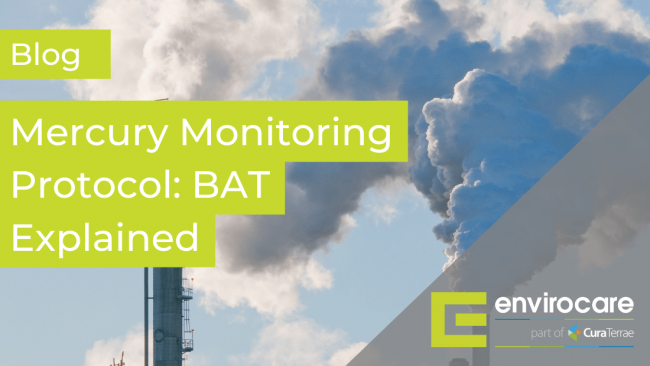Mercury Monitoring Protocol and Best Available Technique
28 July 2022

BAT stands for ‘Best Available Techniques’, referring to the techniques that best prevent or minimise environmental impacts from industry processes/installations. These will be the most economically and technically viable options. ‘Techniques’ refers to the technology used, but also the way the installation is designed, built, maintained, and operated.
The ‘Best Available Techniques’ for an installation will come from the European BRef (best available technique reference) documents. The European Commission produces these best available technique reference documents, or ‘BRef’ notes. These are the result of investigative work. You need to adhere to BAT protocol if you have an Installation Environmental Permit with the EA.
The New Mercury Monitoring Protocol
The latest changes to the Waste Incineration (WI) BAT Conclusions document came in December 2019. BAT number 4 in the 2019 Waste Incineration BREF BAT Conclusions (or WI BATC) requires continuous emissions monitoring for mercury. This is unless you are burning waste with a “proven low and stable mercury content”.
If this is the case, meaning at least 6 periodic Hg results available and the 6 results are all less than 10 µg/Nm3 Hg, plants can instead do periodic monitoring at a minimum frequency of 6 months (or long-term sampling).
The new WI BATC document sets levels as 5-20 µg/Nm3 (daily average) or 1-10 µg/Nm3 (long-term sampling).
The WI Bref BAT Conclusions set a four year transition period, after which all facilities in its scope need to be in compliance.
Mercury CEMS should be fitted as soon as practicable. Once have been fitted, the expectation is that they will become a permanent requirement.
Why must I adhere to the BAT protocol?
The above protocol has been agreed by the UK Regulators to be an appropriate method for an operator to demonstrate that their plant is burning waste with a “proven low and stable mercury content” on the basis of the results of periodic mercury monitoring being consistently below a threshold of 10 µg/Nm3.
What if I have a non-hazardous waste incinerator?
The protocol is voluntary and applies on a per-line basis to all non-hazardous waste incinerators and co-incinerators (both new and existing).
However, hazardous waste incinerators taking multiple hazardous waste types must have mercury CEMs.
What happens if I have a new plant and do not have 6 periodic Hg results?
Accelerated testing for new plants should be completed within 6 months of successful plant commissioning unless otherwise agreed in writing with the regulator e.g. in the event of intermittent operation following commissioning.
Existing Plants
Existing plants must have completed testing for six consecutive results and, in the case where 6 results below the threshold have been obtained, agreed in writing with the regulator that mercury CEMS are not required by 2 December 2023. If they are required you should also have fitted the CEMS by this date (where practicable). Otherwise, where further optimisation and testing is required for existing plant, 6 months will be allowed to complete this.
The WI BREF expects an average value of three consecutive measurements of at least 30 minutes each. Results should be adjusted to standard temperature and pressure and a reference oxygen concentration of 11%. Subtraction of measurement uncertainty from the results is not permitted.
Operators will also need to demonstrate that the 6 results obtained are representative of the expected waste types and plant throughput, and the test house reports must also be submitted.
What if I exceed the Hg limits periodically for 6 months?
A maximum of 3 months will be allowed to rectify the cause, during which monthly mercury monitoring will be required.
A maximum of 3 months will be allowed for further optimisation, during which monthly mercury monitoring is still required.
Operators are expected to monitor waste types and review other sources of data which indicated mercury content of waste (analysis of IBA and APCR) to check that there are no significant increases to the mercury content of the incoming waste.
WID Mercury Monitoring Decision Tree

